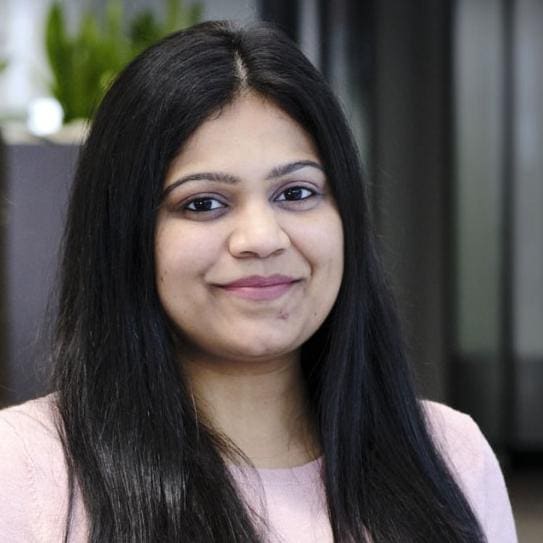USER STORIES
Lifelong learner sets sights on a data science career
Pradnya Pethkar fast-tracks master's degree, then turns an internship into a career she loves.
TOP 3 LESSONS
- Trust your instincts.
- Have a willingness to learn and reinvent yourself.
- Experiment often (use trial and error).
THE JOURNEY
First step: Undergraduate study
Savitribai Phule Pune University: Bachelor of Engineering in electronics and telecommunications.
Second step: Teaching assistant
Teaching Level 5 students engineering mathematics (I and II), differential and integral calculus.
Third step: Postgraduate study and internship
Auckland University of Technology (AUT): Master's in Analytics, including data science internship with Harmoney Ltd.
Fourth step: Career
Working as a data scientist at Harmoney Ltd.
SEE THE BENEFITS
ON BEING UNDERSTOOD
An analytics test that can accurately describe why you do the things you do.
Helping to understand a natural aptitude for analytics.
1 of 2
Master of Analytics programs in New Zealand.
90%+
of AUT Master of Analytics students complete an internship.
ON INSPIRATION
The most valuable skills for an aspiring data scientist:
passion, a drive to never stop learning
and teamwork.
Learning SAS helped me start my career as a data scientist.
MY STORY
Q: Going back to the very beginning – when did you first start thinking about becoming a data scientist? Were there any skills or talents you had when you were younger that led you in this direction?
A: A very interesting observation I made about myself a few years ago, that on an empty piece of paper I often draw random patterns, but all are in sync. Also, as a very outgoing and social person, I always heard that I have an analytical mind. It never amused me until the results of a personality test showed me a very good score in analytical skills. That’s when I realized I have to do something in analytics. Once I made the decision to actually pursue my career in data science, I felt excited and extremely satisfied along the journey.
Q: Why did you apply to study at Auckland University of Technology and specifically the Faculty of Engineering, Computer and Mathematical Sciences/Master of Analytics?
A: I wanted a fast-track master's program designed for less than two years, including the core subjects. Auckland University of Technology had the exact requirements. The course structure was a program of 180 credits over one and a half years. To top it all, the course structure had an internship of 60 credits, which immediately interested me to apply.
Q: Tell me about your college experience. What types of technology courses did you take? Was there one course in particular that really sparked your interest in computer science?
A: The college experience was mesmerizing! Every subject I studied had its practical implementation, which forced me to learn the concepts quickly. I really enjoyed computational mathematics and statistics, which developed skills to perform data analysis and visualization using the complete software package of R, MATLAB and SAS.
Q: How did studying for the Master of Analytics affect your thinking about what you would do once you graduated?
A: I was pursuing my internship with Harmoney (an online lending platform) by working on a project – fraud detection – which gave me an analytical approach to designing, executing, reporting and solving a real-life data science problem. At this time, I thought that a great day at the office would be doing a smart analysis of financial data that can bring value to the company, and what’s even better is that I get to enhance my skills and broaden my knowledge at the same time!
Read more of Pradnya's story
Q: At what point did you learn about SAS? Did you take any SAS-oriented courses in college or grad school?
A: I was completely unaware of the tool until I started with my master's program. I was immediately drawn to SAS when it was first introduced to me. I had worked on a case study, entirely completed using SAS – to build the most cost-effective 24-hour schedule for the water distribution network and provide a cost-benefit analysis of the proposed changes.
Q: What happened after grad school – did you land a job right away, or did you take a more indirect career path?
A: I secured a full-time position as a data scientist with Harmoney (the same company I had interned for). It was a dream come true for me.
Q: Tell me about your current job. What skills do you get to use? What do you like about it?
A: Harmoney is one of Australasia's leading tech-enabled online lenders, giving people a quick and simple way to borrow online. Harmoney has its own technological platform – Stellare™ – which encompasses different modules like credit decisions, loan management, customer experience, data flow and business intelligence, and machine learning. Harmoney uses leading-edge technologies and tools like DataRobot, Snowflake, Tableau, Salesforce and many more. Being a part of such a technology-driven and dynamic company intrigues me!
Q: Looking back on your entire education/career path, were there any roadblocks or problems you encountered? Anything you’d do differently?
A: The research project during my internship was a challenging one. There were times when I was stuck, and nothing was helping. My mentors Andrew Cathie (Chief Data Scientist at Harmoney), and Sarah Marshall (Senior Lecturer at Auckland University of Technology) helped me by giving quick suggestions. Of course, Google was and is a savior at all times!
Q: Where are you now in terms of your career journey? Are you a lifelong learner? If so, are there things you’re working toward now?
A: I am a lifelong learner. I always believe in “learn to learn.” I am really looking forward to continuing to develop and enhance the work on fraud detection that I started as part of my internship.
Q: What other advice would you give to a university student thinking about wanting to learn about SAS?
A: SAS is a comprehensive analytical tool. SAS has readily available documentation, which is of immense help to code. SAS certifications are recognized worldwide and help to display competent skills, which is an advantage for the career. SAS is also a groundbreaking tool for advanced predictive and statistical analytics used by top banks and financial corporations to establish insights from their financial data. Learning SAS will definitely help in the long run.
Unfold the stories using data science that can make the world a better place.
TOOLS FOR SUCCESS
SAS® Fraud Management
Identify and respond to unwanted and suspicious behavior in real time – from a single platform. SAS Fraud Management uses data analytics and machine learning to help you detect, prevent and manage fraud across the enterprise.
SAS® Certified Advanced Analytics Professional Using SAS®9
For individuals who want to analyze big data with a variety of statistical analysis and predictive modeling techniques.

Explore Amazing Careers in Analytics


